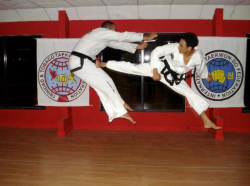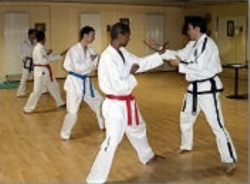Knowledge of Taekwondo for 8th KUP
Knowledge /
Main Menu
Knowledge of Taekwondo for 8th KUP
Exam 8th Kup
Document containing source information
The magic number 9:
One starts with 9th kup and ends 9th Dan in Taekwondo because 9 is a magic number for the Asians.
Multiply it by any other number, and the sum of the digits of the result is always 9. Ex.: 9 x 112 = 1008 the sum of digits: 1 + 0 + 0 + 8 = 9.
The number 9 in the East is an important sacred number. Moreover, it is mysterious, because it keeps coming back.
Sparring
A Taekwondo fight on competition will be decided by points and takes two minutes. There are four corner referees who give points and one ring referee on the field provided.
Point allocation
In sparring, the points are allocated as here below :
- 1 point for all fist techniques on the body or face
- 2 points for all leg techniques on the body
- 3 points for all leg techniques on the face
Warnings:
- Ui Ju Hanna: before a warning is given, the fight is stopped (= heachyo) and then a warning is attributed to the accused person. After three warnings, one point is deducted.
- Gam Jum Hanna: you can get a minus point through full contact (too hard, usually uncontrolled), falling down or ignoring umpire commands. Three direct minus points means disqualification (Sil Kyuk).
You get a warning by :
- Pushing
- Kicking below the belt
- Grabbing opponent
- Performing a technique on the back
- Deliberately avoiding battle (running away)
- Falling down (touch by hand on ground)
- Going out of the ring
- Attacking without looking
- turning away
- talking
- Claiming provoking point
Back to top of page - Back to Welcome Page
Matsogi (step sparring)
Taekwondo students learn the techniques of Matsogi. Those are taught with the movements from the tuls to learn how to apply them in sparring.
There are three types of Matsogi: Sambo Matsogi (three step sparring), Ibo Matsogi (two-step sparring) and Il- bo Matsogi (one step sparring).
For the yellow belt exam, candidates must perform five three steps. This is done in pairs.
Methodology
You stand facing each other, bow to each other, then the attacker (pre-arranged) measures the distance needed to perform the attack. After that, the attacker goes backward with his right leg in gunnun sogi najunde bakat palmok makgi. This is the initial position in which each three-step is carried out.
In theory, the defender determines which attack will be performed, but for practical reasons (on the distance between the performers), we recommend that the attacker decides which attack he will be performing. After all, the defender knows beforehand what technique the attacker will use).
Once the attacker has called the technique, he states that he is ready to attack ("TSE"). The defender ponders what technique he will use to defend and indicates that he is ready ("TSE"). The defender may take his time to get prepared for.
Afterwards the attacker kicks or punches and the defender defends/blocks three times. The defender then performs a counterattack.
Then reverse roles. The attacker brings his front leg back to NARANI SOGI (ie backwards) and the defender brings his back leg forward to NARANI SOGI. Now it's up to the person who has just defended for to attack.
Attention to:
It is important to set the feet in the right place. In an attack in niunja sogi, the attacker's feet are placed on the outside of the feet of the defender. If an attack is in gunnun sogi the foot of the attacker is placed on the right side of the foot of the defender, so first on the outside and second time on the inside.
The defender performs a counterattack depending on the distance between the two people. If the distance is large then a kicking technique can be used; it is recommended to have a hand technique at a short distance.

